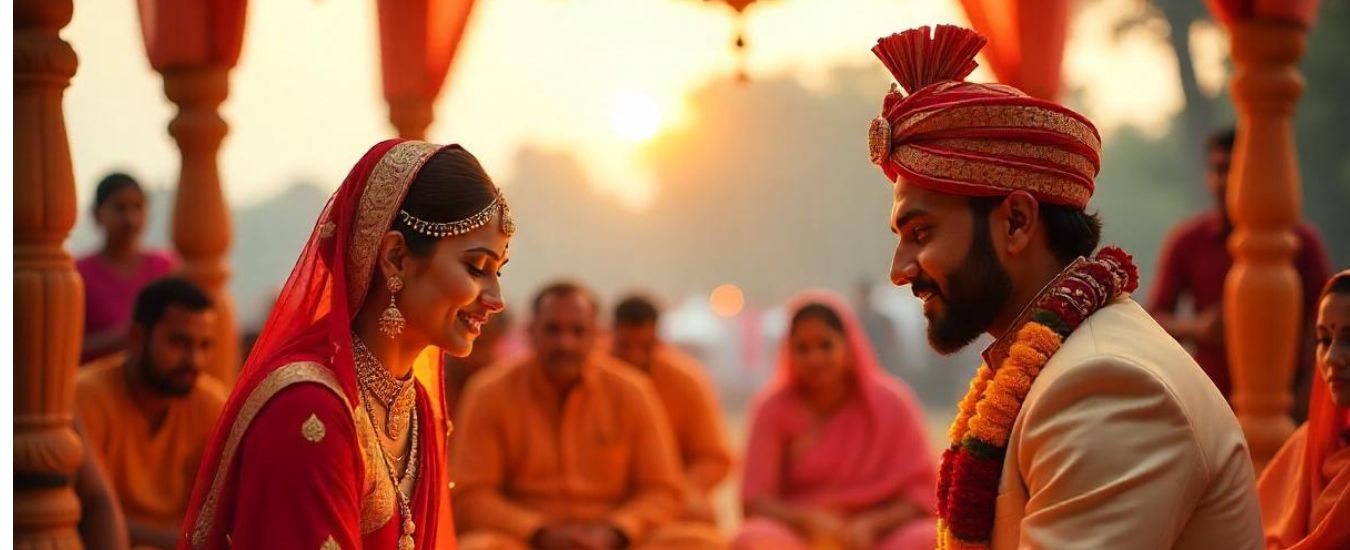Weddings in Bihar aren’t just ceremonies—they’re grand, colourful cultural festivals that overflow with emotion, tradition, and community spirit. Whether it’s the beating of the dhol, the earthy aroma of homemade sweets, or the spiritual essence of Vedic wedding rituals, Bihari weddings have a charm all their own.
Bihari weddings are not just ceremonies—they are immersive cultural narratives rooted in tradition, love, and evolution. As modern elements blend with ancient Indian wedding rituals, the essence of Bihari heritage continues to shine through every phera, folk song, and heartfelt goodbye.
If you’ve ever wondered about traditional Indian matrimonial ceremonies, buckle up! Let’s journey through the vibrant customs that make a Bihari wedding unforgettable with Aagrah Banquet.
What Makes Bihari Weddings Unique?
Bihari weddings reflect a blend of sacred nuptials, familial bonds, and deep-rooted customs. With strong roots in Vedic traditions, every aspect—from the kundli matching to the symbolic rituals—is carried out with authenticity and grace.
Regional Influences and Cultural Significance
Regions like Mithila, Magadh, and Bhojpuri territories each add a distinct flavour. From Maithili art on the mandap to folk songs like Sohar, every custom narrates a story passed down through generations.
Pre-Wedding Rituals
Fixing the Match (Roka or Pakadua Vivah)
Arranged marriages are still common. Horoscope compatibility (Kundli Milan) plays a major role. In some villages, traditions like Pakadua Vivah (now rare) add a quirky twist to this matrimonial alliance.
Engagement (Tilak or Sagai)
Symbolizes formal agreement between families. The groom receives gifts—jewellery, clothes, Aarti Thali, and sweets—along with a tikka. It’s a mix of blessings and pride.
Mehendi and Haldi Ceremonies
While the Haldi Kutai ritual uses turmeric for spiritual purification, the Mehendi ceremony is a festive event where henna is applied to the bride’s hands, symbolizing love and good fortune.
Mandapachadan, Matkor, and Kalash Sthapana
The wedding mandap is built using bamboo and mango leaves. Matkor involves collecting sacred clay, and Kalash Sthapana marks the sanctification of space with a pot of holy water.
Wedding Day Rituals
The Vibrant Baraat Procession
The groom’s baraat—often on horseback—parades with music, dancing, and fanfare. Phoolon ki chadar may also be used during the bride’s entrance.
Welcoming the Groom (Baran Dwar)
He’s greeted with an aarti, songs, and playful games like mock negotiations. It’s full of laughter and tradition.
Sacred Rituals: Kanyadaan, Saat Phere, Saptapadi
The couple circles the Agni in seven rounds (Saat Phere), each representing a marital vow. These are part of the Saptapadi, the sacred seven-step promise. The bride’s father performs Kanyadaan, handing over his daughter with blessings.
Sindoor Daan and Mangalsutra
The groom applies Sindoor and ties the Mangalsutra—symbols of a married Hindu woman. It’s a divine moment of union.
Post-Wedding Traditions
Bidai and Doli
The Bidai is a heartfelt farewell. In some areas, the bride leaves in a Doli—a traditional bridal palanquin.
Griha Pravesh and Gauna
At the groom’s home, the bride performs Griha Pravesh—stepping in after kicking a pot of rice. In some Bihari communities, the marriage is consummated only after Gauna, a delayed ritual.
Chaturthi (Chauthi)
On the fourth day, the bride returns to her parental home with her husband—called Chaturthi or Chauthi—symbolizing the renewal of family bonds.
Symbolism in Attire and Accessories
Bride and Groom’s Dress
Brides wear red or maroon Banarasi sarees adorned with gold, chura (bridal bangles), bichiya (toe rings), and nose rings. Grooms don Sherwani, dhoti-kurta, safa, and Sehra.
Food and Festivities
Traditional Bihari Cuisine
Feasts feature litti-chokha, kadhi-bari, thekua, and malpua, served on pattal (leaf plates) or banana leaves for an earthy feel.
Music, Dance, and Folk Celebrations
Folk music is integral. Songs like Sohar, Jatsaar, and humorous verses tease relatives and celebrate the union.
Community, Religion & Modern Influence
Hindu and Muslim Wedding Variations
While this focuses on Hindu Bihari weddings, Muslim rituals like Nikah, Mehendi, and Walima are equally vibrant.
Extended Family and Neighborhood Roles
Weddings are communal affairs. From cooking to decoration, everyone pitches in.
Modern Trends and Fusion Elements
Urban couples blend tradition with modernity—adding pre-wedding shoots, wedding planners, DJs, and sometimes hosting destination weddings in Patna, Gaya, or Goa.
FAQs
What is the significance of the Haldi ceremony in Bihari weddings?
The Haldi ceremony purifies the body, removes bad omens, and prepares the bride and groom spiritually and emotionally for marriage.
How are Bihari weddings different from other Indian weddings?
They are deeply rooted in Vedic rituals, community involvement, and folk traditions like Sohar songs and unique pre-wedding customs.
What is the role of folk music in Bihari wedding celebrations?
Folk songs add emotion, humour, and cultural depth. They narrate wedding stories, tease relatives, and build bonds.
Do Bihari weddings involve horoscope matching?
Yes, horoscope or kundli matching is crucial and often the first step in arranging the marriage.
Are arranged marriages still common in Bihar?
Absolutely. While love marriages are rising, arranged marriages—with family involvement—are still the norm in many communities.
